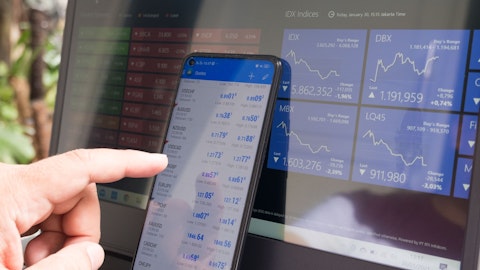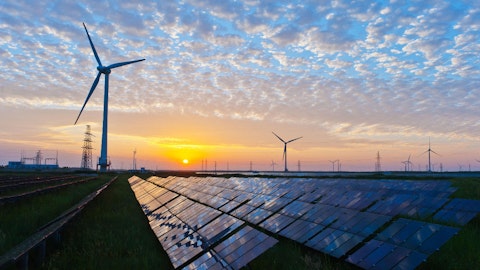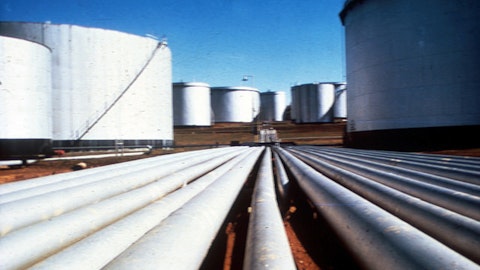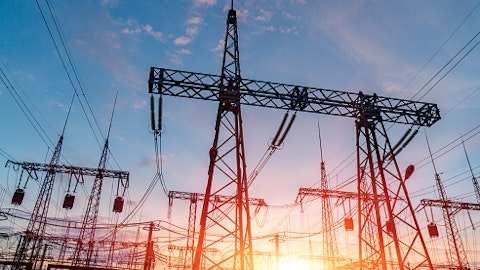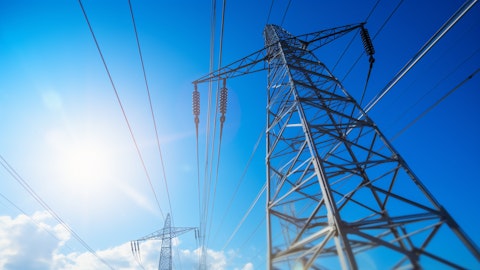New Jersey Resources Corporation (NYSE:NJR) Q1 2024 Earnings Call Transcript February 6, 2024
New Jersey Resources Corporation beats earnings expectations. Reported EPS is $0.907, expectations were $0.82. NJR isn’t one of the 30 most popular stocks among hedge funds at the end of the third quarter (see the details here).
Operator: Thank you for standing by. My name is Jessica, and I will be your conference operator today. At this time, I would like to welcome everyone to the New Jersey Resources, Fiscal 2024 First Quarter Conference Call. All lines have been placed on mute to prevent any background noise. After the speaker’s remarks, there will be a question-and-answer session. [Operator Instructions]. Thank you. I would now like to turn the call over to Adam Prior, Director of Investor Relations. Please go ahead.
Adam Prior : Thank you. Welcome to New Jersey Resources Fiscal 2024 First Quarter Conference Call and Webcast. I am joined here today by Stephen Westhoven, our President and CEO; Roberto Bel, our Senior Vice President and Chief Financial Officer, as well as other members of our Senior Management Team. Certain statements in today’s call contain estimates and other forward-looking statements within the meaning of the securities laws. We wish to caution listeners of this call that the current expectations, assumptions, and beliefs forming the basis of our forward-looking statements include many factors that are beyond our ability to control or estimate precisely. This could cause results to materially differ from our expectations as found on slide one.
These items can also be found in the forward-looking statement section of today’s earnings release, furnished on Form 8-K, and in our most recent forms 10-K and 10-Q as filed with the SEC. We do not, by including this statement, assume any obligation to review or revise any particular forward-looking statements referenced herein in light of future events. We will also be referring to certain non-GAAP financial measures such as net financial earnings or NFE. We believe that NFE, net financial loss, utility gross margin, financial margin, adjusted funds from operations, and adjusted debt provide a more complete understanding of our financial performance. However, these non-GAAP measures are not intended to be a substitute for GAAP. Our non-GAAP financial measures are discussed more fully in item seven of our 10-K.
The slides accompanying today’s presentation are available on our website and were furnished on Form 8-K filed this morning. Our agenda for today is found on slide four. Steve will begin with this quarter’s highlights, followed by Roberta, who will review our financial results. Then we will open the call for your questions. With that, I will turn the call over to our President and CEO, Steve Westhoven. Please go ahead, Steve.
Stephen Westhoven : Thanks, Adam. Good morning, everyone. Fiscal 2024 is off to a good start, and we delivered strong performance in the first quarter. Positive momentum continued in the start of the second quarter as energy services outperformed in January, capitalizing on weather volatility. As a result, we are announcing a $0.15 increase in our NFEPS guidance to $2.85 to $3.00 per share. Before we discuss our quarterly results and forecast more fully, I’ll begin with an update on our sustainability and decarburization efforts on slide five. Last month, we issued NJR’s fiscal 2023 Corporate Sustainability Report, our 15th consecutive report dating back to 2008. This report is an important part of our commitment to transparency with all of our stakeholders in the evolving energy landscape.
It details our leadership and accomplishments in emissions reduction and renewable energy, as well as our long-term vision for the role of existing pipeline infrastructure in a lower carbon future. Just as important, this year’s report also shows how the strong culture of innovation in our organization is having a positive impact on how we execute strategies, engage in dynamic partnerships, and deploy cutting-edge technology in new ways. I’d like to cover just a few of the report’s highlights. Last year, we invested approximately $60 million in SAVEGREEN, New Jersey Natural Gas energy efficiency program. Clean energy ventures continue to innovate, commissioning the largest cap landfill and floating solar arrays in North America. We advanced cutting-edge, lower carbon energy solutions, including the installation of localized carbon capture technology at our Wall, New Jersey headquarters, and high-efficiency gas heat pumps at other facilities in the state.
And as I mentioned, we engaged in new partnerships with a number of well-known academic and research entities to support our innovation efforts. Finally, NJR was recognized by Newsweek as one of America’s most responsible companies for the 5th consecutive year. We hope that you’ve all had an opportunity to review the report. Moving to the first quarter and year-to-date operating highlights on slide six, we executed our business strategy and delivered net financial earnings of $0.74 per share in the first quarter, which was in line with our expectations. At New Jersey Natural Gas, we filed a base rate case to recover capital investments of approximately $850 million since the settlement of our last rate case in 2021. In addition, New Jersey Natural Gas filed for a new SAVEGREEN program of approximately $482 million, which is the largest energy efficiency filing in our history.
At Clean Energy Ventures, we placed another 4 megawatts into service and continue to grow and diversify our project pipeline. And finally, reported solid contributions from S&T and Energy Services, in line with expectations. Moving to slide seven, in November, we provided the NFEPS initial guidance range of $2.70 per share to $2.85 per share. And as I mentioned earlier, we benefited from our outperformance in energy services during the January weather event that allowed us to raise our NFEPS 2024 NFEPS guidance by $0.15 to $2.85 to $3 per share. As discussed in prior calls, we expect fiscal 2024 to exceed our stated 7% to 9% long-term growth rate. Slide eight shows the expected NFEPS contribution by business segment for fiscal year 2024, which reflects the AMA contribution, as well as a significant portion of our net financial earnings coming from our utility business.

Looking ahead, we feel comfortable with our long-term growth rate in future years, and we expect to return to a more normalized segment contribution in fiscal 2025. With that, I’ll turn to discussion of our business units beginning on slide nine. We invested $102 million at New Jersey Natural Gas through a variety of programs in the first quarter of fiscal 2024, with 46% of that CapEx providing near real-time returns. Within that 46% is the SAVEGREEN program as I mentioned earlier, which helps residential and commercial customers lower their energy usage. We spent approximately $13 million in the first quarter to help our customers save money and reduce their carbon footprint. Finally, we achieved solid new customer growth during the period, adding approximately 2,100 new customers through the combination of new construction and conversions.
Slide 10 provides additional detail on our base rate case filings. On January 31st we requested an increase of base rates of $222.6 million, equivalent to an increase of approximately $159 million in operating income. Since the conclusion of our last case in 2021, New Jersey Natural Gas has invested nearly $850 million to upgrade and enhance the safety and reliability of our transmission and distribution systems, as well as our IT investments. Moving to slide 11, our solar business, Clean Energy Ventures, followed an exceptional 2023 with continued momentum heading into the New Year. We added 4 megawatts of new solar capacity and continue to grow our pipeline, which now includes approximately 870 megawatts of potential investment options. Over the past few years we have continued to expand our portfolio geographically, with 51% of our pipeline now located outside of New Jersey.
Our focus is on delivering solar investment opportunities that provide high single-digit unlevered returns. With that, I’ll turn the call to Roberto for a review of our financial results. Roberto?
Roberto Bel: Thank you, Steve, and good morning everyone. Slide 13 shows the main drivers of our NFE for the first quarter of fiscal 2024. We reported an NFE of $72.4 million or $0.74 per share, compared with an NFE of $110.3 million or $1.14 per share last year. New Jersey Natural Gas reported NFE in line with expectations, as higher utility growth margin was offset by higher depreciation and operating expenses. Clean Energy Ventures increased NFE by approximately $14.1 million, largely due to the timing of SREC revenues for the period. Storage and transportation NFE declined versus Q1 of last year as a result of higher operating revenues related to Winter Storm Elliot in the first quarter of fiscal 2023. Finally, Energy Services reported NFE of $7.8 million compared to $52.5 million in Q1 of the prior year.
As a reminder, the first quarter of last year benefited from increased natural gas price volatility related to winter storm Elliot during December of 2022. In addition, AMA revenue recognized in the first quarter of fiscal 2024 was less than that recognized in Q1 of last year. As Steve mentioned earlier, our guidance raise for fiscal 2024 is due to Energy Services self-performance in January 2024, which is our current fiscal second quarter. As we look to the remainder of fiscal 2024, it’s important to note that we expect to recognize a significant portion of AMA’s total revenues later in the year, with the majority being recorded during our fiscal fourth quarter. Turning to our capital plan in slide 14, over the next two years, we expect to invest between $1.2 billion and $1.5 billion across the company.
We did not make any changes to our capital plan compared to our prior goal. Our capital projections are anchored by strong cash flow from operations. On slide 15, you can see that we expect cash flow from operations to range between $450 million and $490 million in both fiscal 2024 and fiscal 2025. Slide 16 shows our credit metrics. We continue to project 10 years adjusted FFO to adjusted debt to be between 17% and 18% for the year. And while we have no plans to issue block equity, our existing AMA reinvestment program includes a waiver discount feature that allows us to raise equity on an opportunistic basis. Finally, on slide 17, we provide a breakout of our long-term debt. As you can see, most of our debt is fixed rate in nature, and we do not have significant maturities in any particular year.
Our NFEPF guidance for fiscal 2024 and our long-term NFEPF growth guidance assume high interest rates for the foreseeable future. We have substantial liquidity at both NJR and NJNG. Overall, we are in an outstanding position to fund our growth objectives. With that, I will turn the call back to Steve.
Stephen Westhoven : Thanks, Roberto. In conclusion, NJR is off to a good start, and we expect fiscal 2024 to be a strong year due to higher NFE contributions from energy services and steady performance from our core businesses. In addition, we have been able to take advantage of the opportunities in energy markets that have resulted in considerable upside to our growth targets in recent years. And as always, I want to thank all of our employees for their hard work. And with that, I will now open the call for your questions.
See also 13 Best American Tech Stocks To Buy According to Analysts and 12 Most Advanced AI Assistants.
Q&A Session
Follow New Jersey Resources Corp (NYSE:NJR)
Follow New Jersey Resources Corp (NYSE:NJR)
Operator: [Operator Instructions]. Our first question comes from the line of Richard Sunderland with J.P. Morgan. Please go ahead.
Richard Sunderland : Hi. Good morning. Can you hear me?
Stephen Westhoven: We can hear you. Good morning, Rich.
Richard Sunderland : Great. Thank you. The $0.15 guidance range — sorry, guidance raise, does that fully reflect the January weather benefit, and not just at energy services, but anything at S&T or even on the BGSS incentive side to the extent realized?
Stephen Westhoven: Yeah. The financial team did a nice job of really going through everything in our budgets and impacts from the weather and tried to put that all into our numbers going forward. So we believe it does fully reflect the January weather event across all the businesses.
Richard Sunderland : Understood. That’s helpful color, thanks. The big SREC sale number at CEV, I guess largely a timing factor. Could you unpack that a little bit more? I was surprised to see that.
Stephen Westhoven: Yeah. You know what? As it goes, those SRECs are commodities. It depends when the sales take place, and we recognize that revenue impact at the time of the sale. So it’s really just dependent on when those transactions really occur. So don’t read anything into it. It’s just our normal business.
Richard Sunderland : Understood. And then I know you put a spotlight on the AMA benefits this year, now the weather benefits from January versus that long-term growth rate. I guess turning to the base growth though in ‘25, could you provide any color around the shape to that, meaning, do you expect it on a base business basis to be linear or should there be a bigger step up in ‘25 given the rate case will be coming in that year?
Stephen Westhoven: I mean, this is really the power of the portfolio of companies. We’re going through a rate case cycle now that should be settled by the time we get to ’25, and you’ve got the slight changes in percentage contribution. We’ve given – we’ve shared with the financial community our growth rate in the company over the period as well as our segment contributions and we expect those to be intact. And as we said before, we expect them to normalize as we go into the future. So I hope that answers your question.
Richard Sunderland : So very helpful color as always, and thank you for the time today.
Stephen Westhoven: Alright. Thanks Rich.
Operator: Your next question comes from the line of Shahriar Pourreza with Guggenheim Partners. Please go ahead.
Shahriar Pourreza : Hey, guys. Good morning.
Stephen Westhoven: Hey Shah.
A – Roberto Bel: Good morning.
Shahriar Pourreza : Morning, morning. So just real quick on the ‘24 financing plans. Obviously you guys now expect to issue slightly less debt, but then also raised your equity issuance guidance despite sort of that unexpected inflow from energy services. I guess just run us, what’s driving the higher equity in plan.
Roberto Bel: Hey, Shah. This is Roberto. The increase in, and it’s a very small increase in equity by the way. It’s related to our DRIFT program. As you know, as part of our equity buyback program – I’m sorry, as part of our DRIFT program, we have the option to issue a little bit of equity and from time-to-time we exercise that option. So that’s really what you’re seeing there.
Shahriar Pourreza : Okay. Okay, got it. And then just, I know obviously highlighted a little bit peak earnings from the Asset Management Agreement you struck in 2020. Just I guess, remind us what the remaining years kind of look like in terms of earnings and cash contribution and sort of the cadence, especially as we’re thinking about ‘25 and beyond. Just maybe just elaborate a little bit on that prepared remarks. Thanks.
Roberto Bel: Yeah. This is Roberto again, Shah. So as you know, this is going to be the peak year for AMA in terms of our revenue contributions. From here on, between ‘25 and ‘31, we have a little bit of a step down in terms of the earnings per year. And every year they become, in terms of revenues, around $15 million to $20 million.
Shahriar Pourreza : Okay, got it. And let me just, I know this was asked in the prior question, but I just want to maybe hit it a little bit more accurately. Are you – with sort of the step downs that you’re seeing with AMA and maybe the energy services business going to a little bit more of a recurring figure versus what you’re seeing now, are you just confident that you can hit sort of the midpoint of that guidance range at least to show linear or should we just assume some gyrations? I know that was sort of the impetus of the prior question, but I didn’t get a sense on whether you still assume there’s going to be linearity that spikes some of the step down in earnings we should be expecting in the near term.
Stephen Westhoven: Yeah, we’ll confirm our long-term growth range. It’s kind of the best I can do. We’ll normalize it to history. You do have a spike and we expect some other business units to contribute more going forward as you’d expect. That is the percentage that’s normalized. But yeah, we’re confirming our long-term growth rate.
Roberto Bel: Just to clarify Shah, as we were saying in our earnings presentation, you should take our initial 2022 guidance and then basically grow that between 7% and 9% every year to find what our normalized expected earnings are going to be every year.

